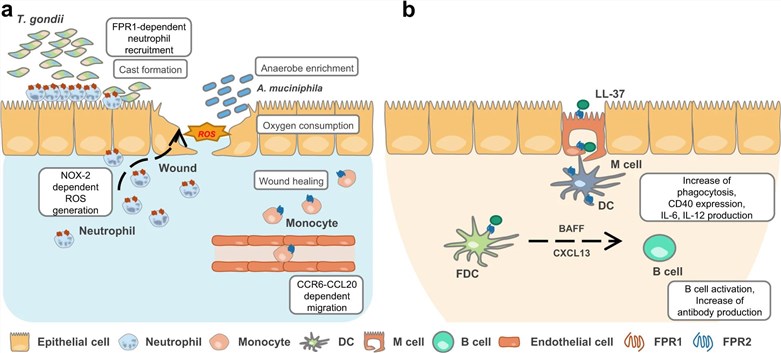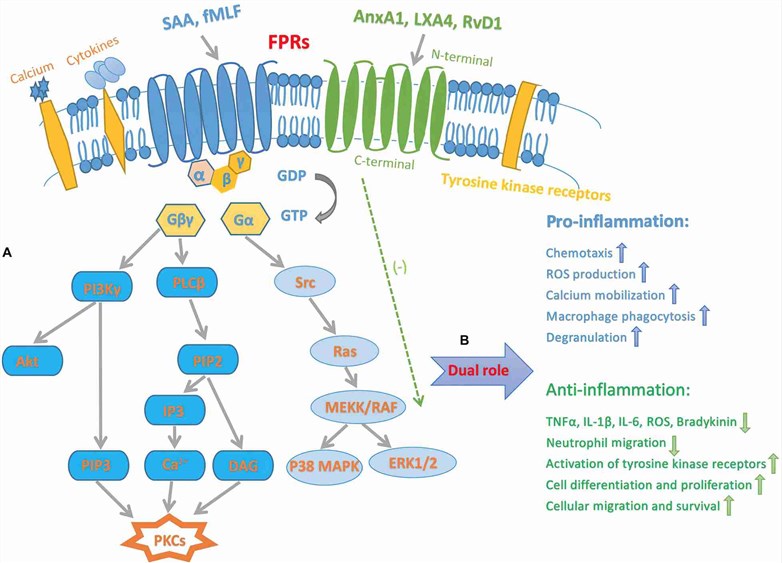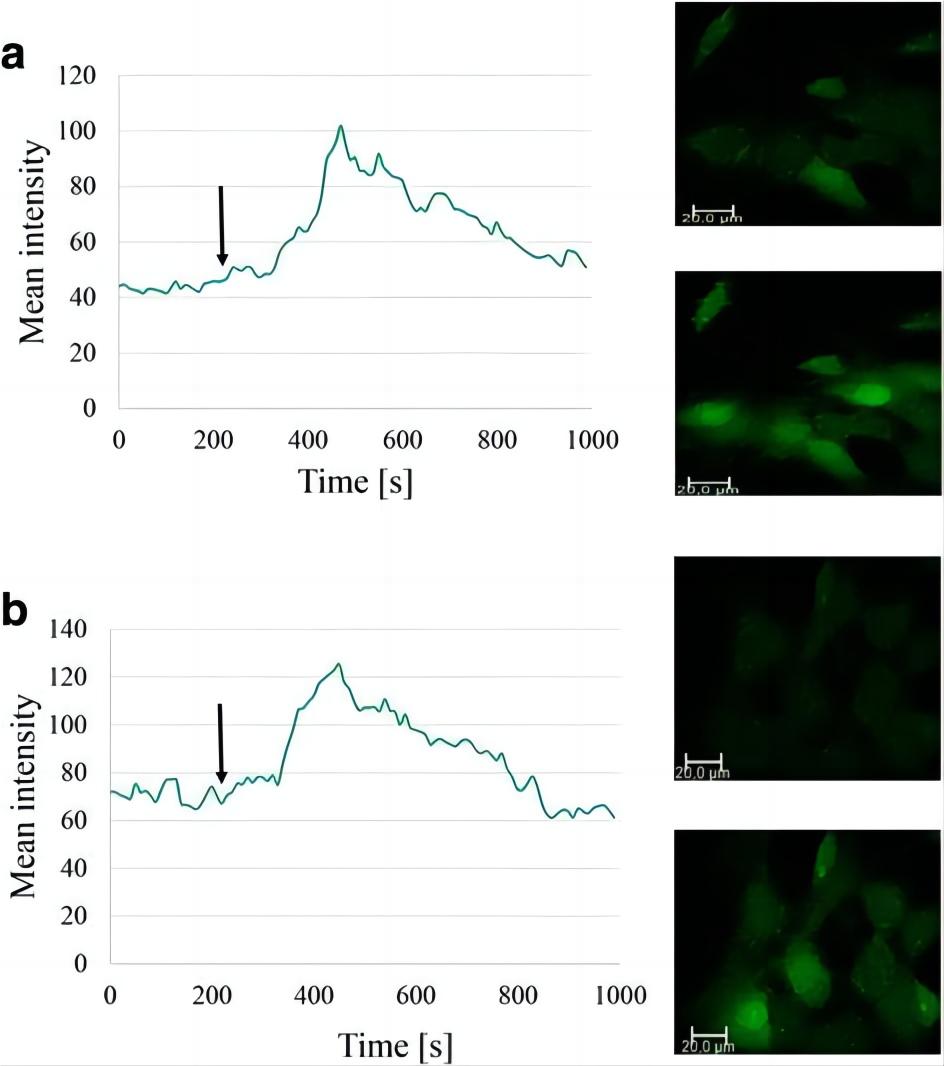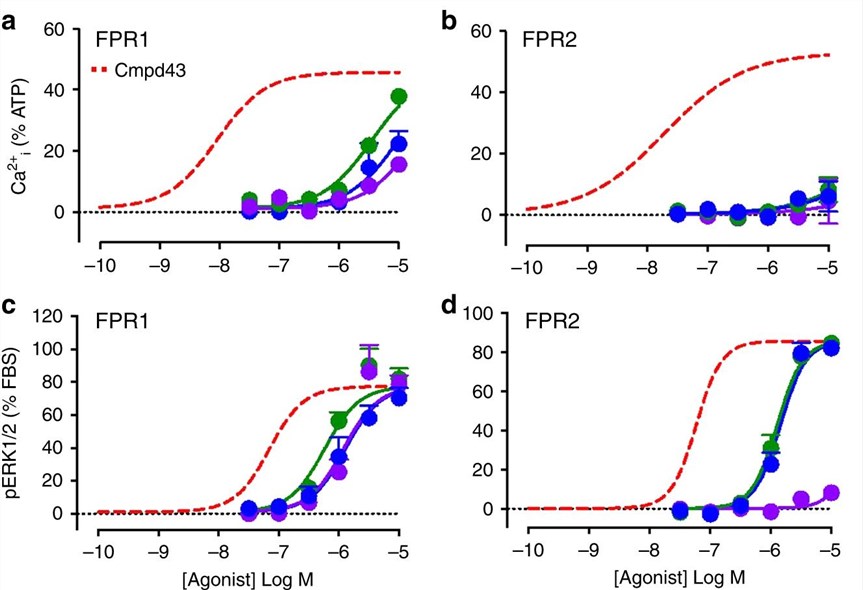Hi-Affi™ In Vitro Cell based Formylpeptide Receptor Functional Assay Service
Formylpeptide Receptors: Why They Matter
The formyl peptide receptors (FPRs), of which there are three types: FPR1, FPR2, and FPR3, are a family of G protein-coupled chemoattractant receptors with critical functions in host defense and inflammation. In addition to binding N-formyl peptides from bacteria and mitochondria, these receptors also bind non-formyl peptides from bacteria and the host. Various diseases such as inflammatory response, multiple sclerosis, and neurodegenerative diseases are involved in the participation and mediation of FPRs. Hence, it is noteworthy to identify the formyl peptide receptors clearly, which will benefit the drug development of diseases.
 Fig.1 FPRs' regulatory functions in gastrointestinal (GI) immune responses.1
Fig.1 FPRs' regulatory functions in gastrointestinal (GI) immune responses.1
Creative Biolabs Integrates In Vitro Cell-Based Assay with Formylpeptide Receptor Functional Assay
The use of cell-based in vitro assay has become commonplace in medicinal chemistry as a means of aiding the discovery of structurally diverse compounds that may have therapeutic potential. The sensitivity and repeatability of this approach are excellent. Creative Biolabs integrates this approach with GPCR functional assay and has successfully developed a Hi-Affi™ in vitro cell-based formylpeptide receptor functional assay service.
Our Hi-Affi™ in vitro cell-based formylpeptide receptor functional assay service is carried out by assessing the change of second messengers and fluorescence intensity triggered by the response of ligands and formylpeptide receptors, which is capable of assaying compounds and analyzing their ability to modulate formylpeptide receptors. Creative Biolabs offers a comprehensive array of services, from the design of experiments to the verification of data, to assist with the projects of global customers.
 Fig.2 Inflammatory signaling pathways of FPRs.2
Fig.2 Inflammatory signaling pathways of FPRs.2
Benefit of Our Hi-Affi™ In Vitro Cell-Based Formylpeptide Receptor Functional Assay Service
- A wide variety of cell types are fundamental to our Hi-Affi™ in vitro cell-based formylpeptide receptor functional assay service.
- Robust and reliable experiment systems empower our Hi-Affi™ in vitro cell-based formylpeptide receptor functional assay service.
- The highly sensitive and repeatability of experiment systems facilitate our Hi-Affi™ in vitro cell-based formylpeptide receptor functional assay service.
- Professional and experienced research teams guarantee our Hi-Affi™ in vitro cell-based formylpeptide receptor functional assay service.
- A full range of customized services enables our Hi-Affi™ in vitro cell-based formylpeptide receptor functional assay service.
Case Study
Methods: The expression of FPR1 was examined in neuroblastoma cell lines and primary tumors through various techniques including RT-PCR, WB, immunofluorescence, and immunohistochemistry. Its functional activity in neuroblastoma was assessed utilizing calcium mobilization assays and WB using phospho-specific antibodies.
Results: In both primary tumors and cell lines, FPR1 is expressed. High FPR1 expression correlates with high disease risk and low patient survival. In neuroblastoma cells, fMLP, a selective FPR1 agonist, activated the P38-MAPK, PI3K/Akt, and MAPK/Erk signal transduction pathways and caused intracellular calcium mobilization. Cyclosporin H, a specific FPR1 receptor antagonist, blocked these effects.
 Fig.3 Stimulation of FPR1 facilitates intracellular Ca2+ mobilization.3
Fig.3 Stimulation of FPR1 facilitates intracellular Ca2+ mobilization.3
Methods: Stably transfected recombinant hFPR-CHO cells were subjected to (±)Cmpd17b, (+)Cmpd17b, and (−)Cmpd17b to generate concentration-response curves for intracellular Ca2+(Ca2+i) mobilization and ERK1/2 phosphorylation.
Results: Biased agonist R, S-(±)-Cmpd17b at FPR1 and FPR2 induces much less Ca2+ mobilization downstream of FPR1 and FPR2 compared to ERK1/2 signal transduction.
 Fig.4 R, S-(±)Cmpd17b and its enantiomers' signaling fingerprint in CHO cells stably expressing hFPRs.4
Fig.4 R, S-(±)Cmpd17b and its enantiomers' signaling fingerprint in CHO cells stably expressing hFPRs.4
Work with Creative Biolabs

As an industry leader, Creative Biolabs is dedicated to providing each client with state-of-the-art service and innovative approaches in the research of GPCR function. Please feel free to get in touch with us through the aforementioned mode should you like to learn more about our Hi-Affi™ in vitro cell-based formylpeptide receptor functional assay service. Every member of our team is excited to begin a collaboration with you.
References
-
Jeong, Yu Sun, and Yoe-Sik Bae. "Formyl peptide receptors in the mucosal immune system." Experimental & Molecular Medicine 52.10 (2020): 1694-1704.
Distributed under Open Access License CC BY 4.0, without modification. -
Zhu, Jiahui, et al. "The role of formyl peptide receptors in neurological diseases via regulating inflammation." Frontiers in Cellular Neuroscience 15 (2021): 753832.
Distributed under Open Access License CC BY 4.0, without modification. -
Snapkov, Igor, et al. "The role of formyl peptide receptor 1 (FPR1) in neuroblastoma tumorigenesis." BMC cancer 16 (2016): 1-12.
Distributed under Open Access License CC BY 4.0, without modification. -
Qin, Cheng Xue, et al. "Correspondence: Reply to 'Compound 17b and formyl peptide receptor biased agonism in relation to cardioprotective effects in ischemia-reperfusion injury'." Nature Communications 9.1 (2018): 530.
Distributed under Open Access License CC BY 4.0. The original image was modified by extracting and using a part, and the title was changed to "R, S-(±)Cmpd17b and its enantiomers' signaling fingerprint in CHO cells stably expressing hFPRs".
For Research Use Only.
